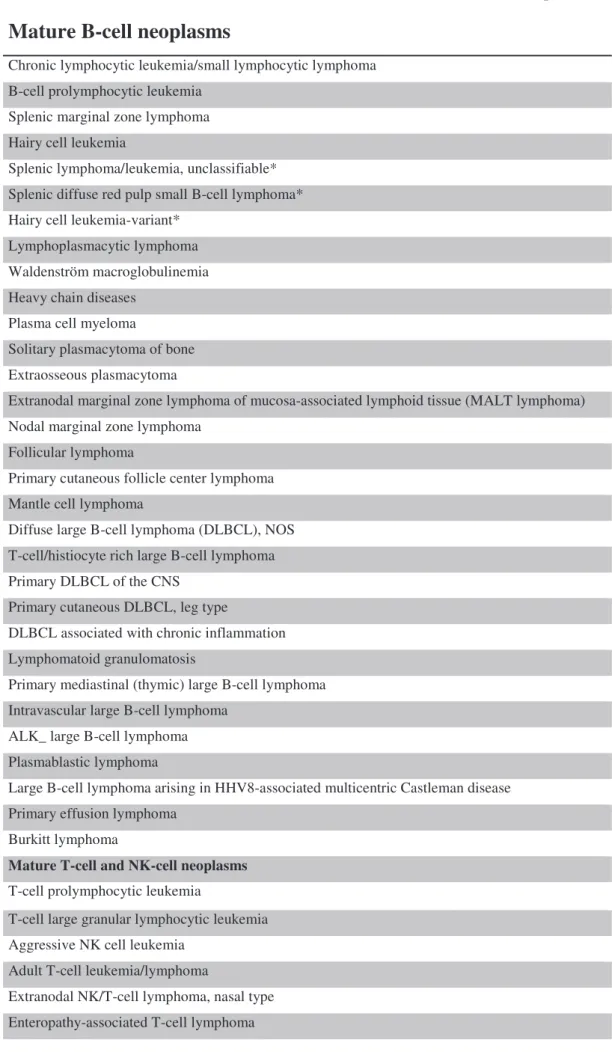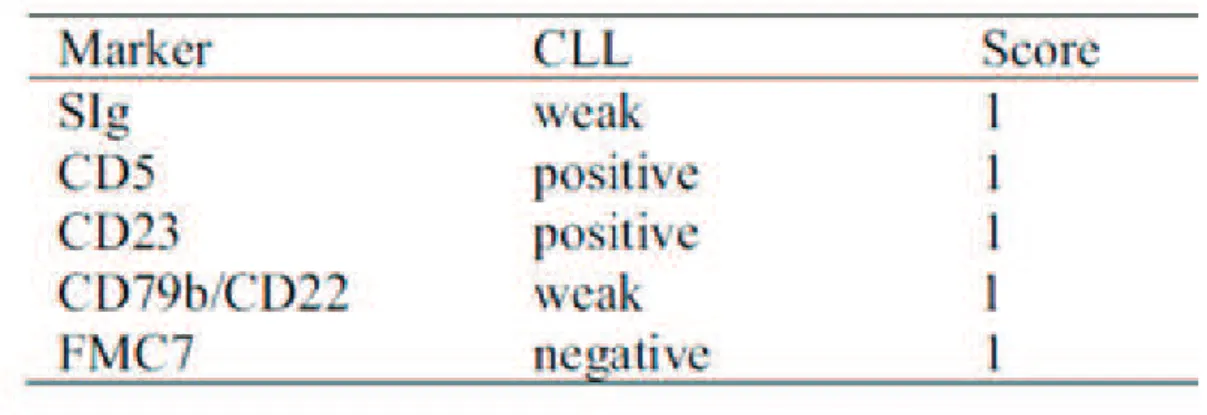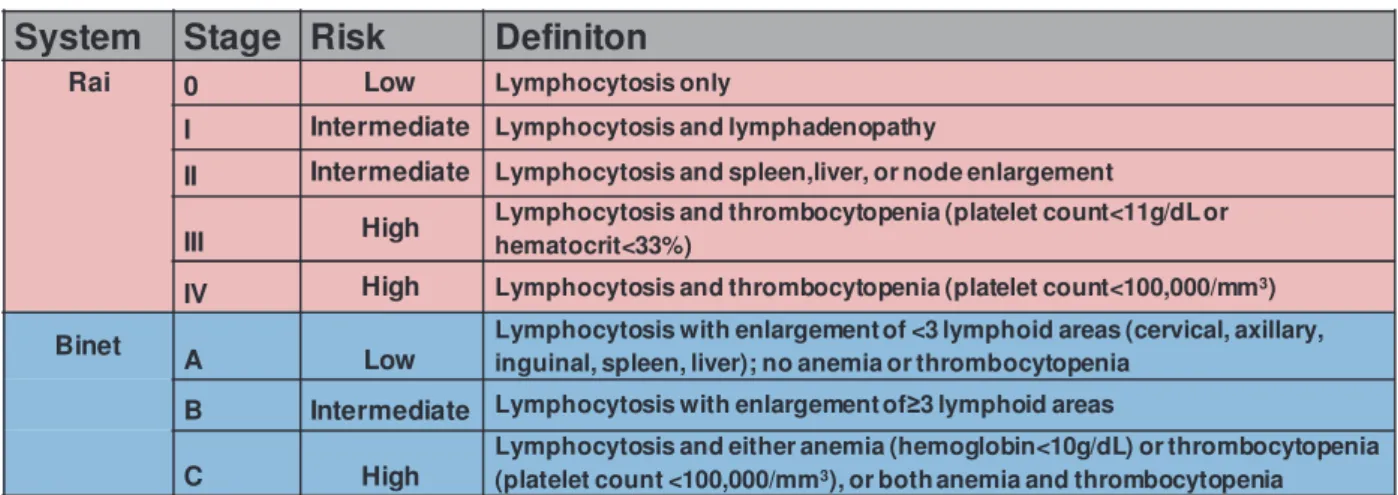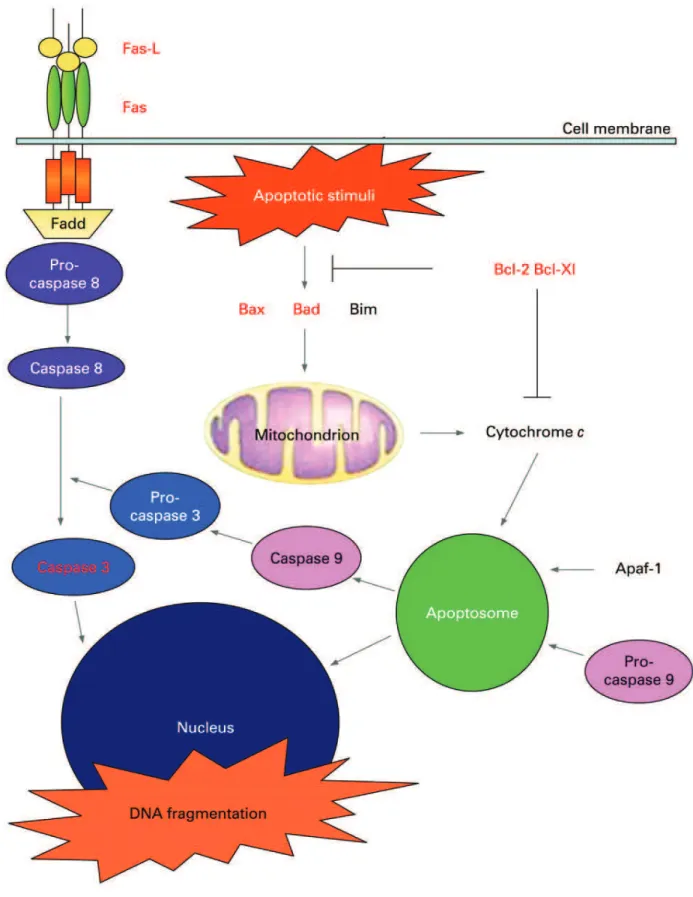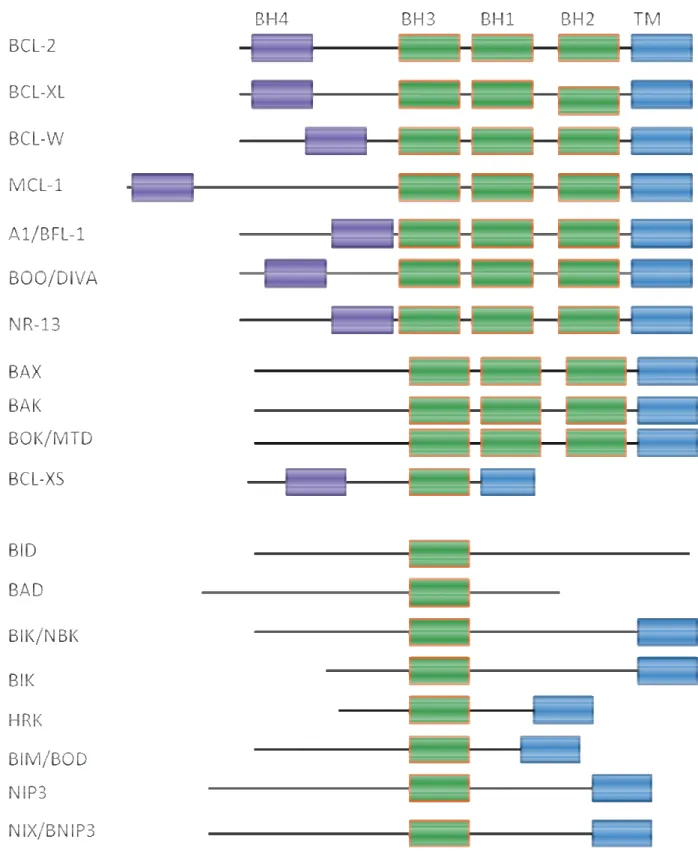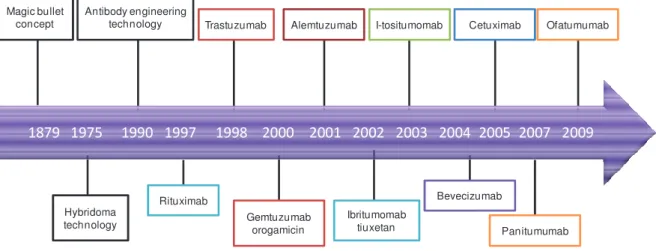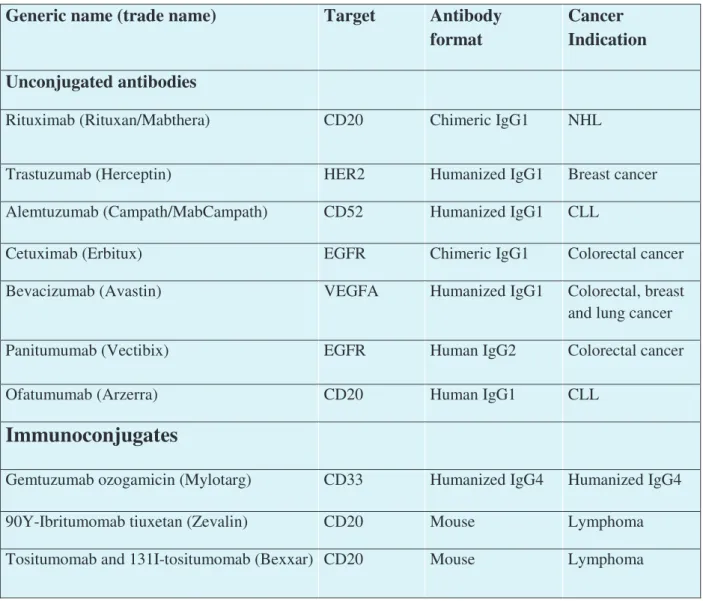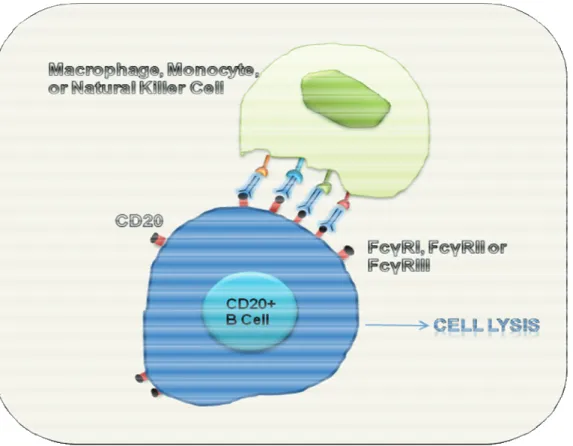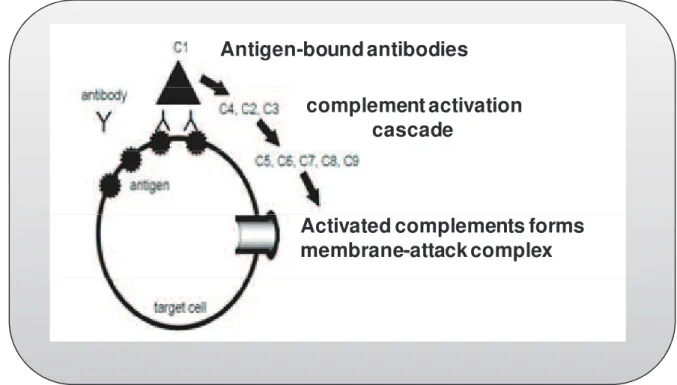Comparison of the cytotoxic mechanisms of anti-CD20
monoclonal antibodies Rituximab and GA101 in
Chronic Lymphocytic Leukemia
Lina Reslan
To cite this version:
Lina Reslan. Comparison of the cytotoxic mechanisms of anti-CD20 monoclonal antibodies
Rituximab and GA101 in Chronic Lymphocytic Leukemia. Human health and pathology.
Universit´e Claude Bernard - Lyon I, 2010. English. .
HAL Id: tel-00863639
https://tel.archives-ouvertes.fr/tel-00863639
Submitted on 19 Sep 2013
HAL is a multi-disciplinary open access archive for the deposit and dissemination of sci-entific research documents, whether they are pub-lished or not. The documents may come from teaching and research institutions in France or abroad, or from public or private research centers.
L’archive ouverte pluridisciplinaire HAL, est destin´ee au d´epˆot et `a la diffusion de documents scientifiques de niveau recherche, publi´es ou non, ´emanant des ´etablissements d’enseignement et de recherche fran¸cais ou ´etrangers, des laboratoires publics ou priv´es.
N° d’ordre : 346-2010 Année : 2010
THESE DE L’UNIVERSITE DE LYON
Délivrée par
L’UNIVERSITE CLAUDE BERNARD LYON 1
ECOLE DOCTORALE
BIOLOGIE MOLECULAIRE, INTEGRATIVE ET CELLULAIRE
DIPLOME DE DOCTORAT
(arrêté du 7 août 2006)
soutenue publiquement le 23 Décembre 2010
par
Melle RESLAN Lina
TITRE :
Comparison of the cytotoxic mechanisms of anti-CD20
monoclonal antibodies Rituximab and GA101 in Chronic
Lymphocytic Leukemia
Directeur de thèse : Pr DUMONTET Charles
JURY :
M. Jean-Christophe Béra, PU, Université Claude Bernard Lyon I Président Mme Catherine Thieblemont, PU-PH, Université Denis Diderot Paris 7 Rapporteur M. Robert Marcus, Professeur, Kings College Hospital, UK Rapporteur Mme Christine Bezombes, Chargée de recherche, INSERM U563, Toulouse Examinateur M. Charles Dumontet, PU-PH, Université Claude Bernard Lyon I Directeur de thèse
N° d’ordre : 346-2010 Année : 2010
THESE DE L’UNIVERSITE DE LYON
Délivrée par
L’UNIVERSITE CLAUDE BERNARD LYON 1
ECOLE DOCTORALE
BIOLOGIE MOLECULAIRE, INTEGRATIVE ET CELLULAIRE
DIPLOME DE DOCTORAT
(arrêté du 7 août 2006)
soutenue publiquement le 23 Décembre 2010
par
Melle RESLAN Lina
TITRE :
Comparison of the cytotoxic mechanisms of anti-CD20
monoclonal antibodies Rituximab and GA101 in Chronic
Lymphocytic Leukemia
Directeur de thèse : Pr DUMONTET Charles
JURY :
M. Jean-Christophe Béra, PU, Université Claude Bernard Lyon I Président Mme Catherine Thieblemont, PU-PH, Université Denis Diderot Paris 7 Rapporteur M. Robert Marcus, Professeur, Kings College Hospital, UK Rapporteur Mme Christine Bezombes, Chargée de recherche, INSERM U563, Toulouse Examinateur M. Charles Dumontet, PU-PH, Université Claude Bernard Lyon I Directeur de thèse
UNIVERSITE CLAUDE BERNARD - LYON 1
Président de l’Université
Vice-président du Conseil Scientifique Vice-président du Conseil d’Administration
Vice-président du Conseil des Etudes et de la Vie Universitaire Secrétaire Général M. le Professeur L. Collet M. le Professeur J-F. Mornex M. le Professeur G. Annat M. le Professeur D. Simon M. G. Gay
COMPOSANTES SANTE
Faculté de Médecine Lyon Est – Claude Bernard Faculté de Médecine Lyon Sud – Charles Mérieux UFR d’Odontologie
Institut des Sciences Pharmaceutiques et Biologiques Institut des Sciences et Techniques de Réadaptation Département de Biologie Humaine
Directeur : M. le Professeur J. Etienne Directeur : M. le Professeur F-N. Gilly Directeur : M. le Professeur D. Bourgeois Directeur : M. le Professeur F. Locher Directeur : M. le Professeur Y. Matillon Directeur : M. le Professeur P. Farge
COMPOSANTES ET DEPARTEMENTS DE SCIENCES ET TECHNOLOGIE
Faculté des Sciences et Technologies Département Biologie
Département Chimie Biochimie Département GEP
Département Informatique Département Mathématiques Département Mécanique Département Physique
Département Sciences de la Terre
UFR Sciences et Techniques des Activités Physiques et Sportives Observatoire de Lyon
Ecole Polytechnique Universitaire de Lyon 1 Institut Universitaire de Technologie de Lyon 1 Institut de Science Financière et d'Assurance Institut Universitaire de Formation des Maîtres
Directeur : M. le Professeur F. Gieres Directeur : M. le Professeur C. Gautier Directeur : Mme le Professeur H. Parrot Directeur : M. N. Siauve
Directeur : M. le Professeur S. Akkouche Directeur : M. le Professeur A. Goldman Directeur : M. le Professeur H. Ben Hadid Directeur : Mme S. Fleck
Directeur : M. le Professeur P. Hantzpergue Directeur : M. C. Collignon
Directeur : M. B. Guiderdoni Directeur : M. le Professeur J. Lieto Directeur : M. le Professeur C. Coulet Directeur : M. le Professeur J-C. Augros Directeur : M R. Bernar
Acknowledgments
It is time for me to recollect the memories of my last three to four years in France... My first travel outside my country with lot of high hopes, ambition, and dreams… New country, new culture, new people, everything made me to have mixed feelings of joy and home sickness for several months and slowly got adapted to new environment. Four years flew away one by one and it is time now to thank everyone who supported me all these days. I still could not believe that my PhD life is coming to an end.
First, I am deeply indebted to my director, Charles Dumontet, for many things, starting from his constant support, his warm encouragement, his thoughtful guidance, his facilities to perform research and his financial aid…
I would like to thank the members of the jury, Jean-Christophe Béra, Catherine Thieblemont, Robert Marcus, and Christine Bezombes for accepting to judge my thesis, for sharing their knowledge directions and valuable comments.
I would like to express my appreciation and gratitude to INSERM U556 for their collaboration…Special thanks for Jean-Louis Mestas for being always here…ready for explaining, preparing the sonoporation procedures, for all his help in experiments and his support…Thanks for Jean-Christophe Béra, for his support, his valuable comments, his continuous encouragement for every new experiments…Thanks for Abbas Sabraoui for his assistance in experimental procedures…
I would like to thank Lars Jordheim and Sandra Ghayad for reviewing my manuscript and articles and for providing advice and comments…
I would like to thank Stéphane Dalle for giving me the opportunity to help him in his articles…Thanks for your support and directions…
I would like to thank all members of the laboratory of Cytologie Analytique: Stéphanie Herveau, Cindy Tournebize, Eva Matera and Emeline Cros for their assistance in experimental procedures…Big thanks to Mylène, Minh Ngoc, Myriam, Anne, Doriane, Karima and all people who passed by the lab…
I would like to thank Anne Béghin, Denis Resnikoff and Batoul for their help and kindness…
Thanks to Minh Ngoc for helping me in binding the manuscript….
Rouba, Sandra and Inès… I really appreciate the bond that we have. Well, we passed hard and happy moments together…we shared happy thoughts, painful memories, dreams and hopes... Those were really great days…We will stay friends forever….
Big thanks to Wafaa and Saeed for being here for me when I needed you…Thank you for your hospitality in my first year in Lyon….You were my small family here…
Many thanks to all my friends who I met in France… Thanks to Ghina Alameh, we passed great memories together…Samar, Lara, Aya, Samer, Rita, Mirna, Salim, Ghassan…you are great friends…I am so glad to have known you and hope we keep in touch…
Millions of thanks for You for everything you gave me…For all your moral support, encouragement, advice….
Where would I be without my family? My parents deserve special mention for their inseparable support and prayers….
Thank you, Mom and Dad, for always telling me you were proud of me… You are my biggest strength... I am very fortunate to be your daughter and I am dedicating this success to you both…I’m here today because of you... I love you…
Big thanks to my lovely sisters (Najwa, Sekna (sousou), Bader and Nour), brothers (Mahmoud, Mhamad and Ali)… nieces (Haya, Dima, Yara) and nephews (Hadi, Louay, Bachar, Layth) … Thank you for your emotional support all those days….Love you all….
Last but not least, I would like to thank GOD for giving me the knowledge, vision, and ability to proceed and “make it so”. It is only through his grace, that achievement can truly be accomplished…
ヱ"
Table of contents
"List of figures ... 4
"Abbreviations ... 5
"Publications ... 9
"Communications ... 10
"Preface ... 11
"Chapter I : Chronic Lymphocytic Leukemia ... 13
" ヱく"] マ エラキS"マ;ノキェミ;ミIキW "くくくくくくくくくくくくくくくくくくくくくくくくくくくくくくくくくくくくくくくくくくくくくくくくくくくくくくくくくくくくくくくくくくくくくくくくくくくくくくくくくくくくくくくくくくくくくくくくくくくくくくくくくくくくくくくくく"ヱン" ヱくヱく"Nミ ラS I キラミ"くくくくくくくくくくくくくくくくくくくくくくくくくくくくくくくくくくくくくくくくくくくくくくくくくくくくくくくくくくくくくくくくくくくくくくくくくくくくくくくくくくくくくくくくくくくくくくくくくくくくくくくくくくくくくくくくくくくくくくくくくくくくくくくく"ヱン" ヱくヲく"1ノ; キaキI; キラミ"ラa"ノ マ エラキS"マ;ノキェミ;ミIキW くくくくくくくくくくくくくくくくくくくくくくくくくくくくくくくくくくくくくくくくくくくくくくくくくくくくくくくくくくくくくくくくくくくくくくくくくくくくくくくくくくくくく"ヱン" ヱくンく"NミIキSWミIW";ミS"W キSWマキラノラェ "ラa"ノ マ エラキS"マ;ノキェミ;ミIキW "くくくくくくくくくくくくくくくくくくくくくくくくくくくくくくくくくくくくくくくくくくくくくくくくくくくくくくくくくくくく"ヱヶ" ヲく"1エ ラミキI"] マ エラI キI"]W ニWマキ;"くくくくくくくくくくくくくくくくくくくくくくくくくくくくくくくくくくくくくくくくくくくくくくくくくくくくくくくくくくくくくくくくくくくくくくくくくくくくくくくくくくくくくくくくくくくくくくくくくくくくく"ヱΑ" ヲくヱく"7Waキミキ キラミ"くくくくくくくくくくくくくくくくくくくくくくくくくくくくくくくくくくくくくくくくくくくくくくくくくくくくくくくくくくくくくくくくくくくくくくくくくくくくくくくくくくくくくくくくくくくくくくくくくくくくくくくくくくくくくくくくくくくくくくくく"ヱΑ" ヲくヲく"; キSWマキラノラェ ";ミS"W キラノラェ "くくくくくくくくくくくくくくくくくくくくくくくくくくくくくくくくくくくくくくくくくくくくくくくくくくくくくくくくくくくくくくくくくくくくくくくくくくくくくくくくくくくくくくくくくくくくくく"ヱΑ" ヲくンく"1ノキミキI;ノ" キェミ "くくくくくくくくくくくくくくくくくくくくくくくくくくくくくくくくくくくくくくくくくくくくくくくくくくくくくくくくくくくくくくくくくくくくくくくくくくくくくくくくくくくくくくくくくくくくくくくくくくくくくくくくくくくくくくくくくくくく"ヱΒ" ヲくヴく"7キ;ェミラ キ "くくくくくくくくくくくくくくくくくくくくくくくくくくくくくくくくくくくくくくくくくくくくくくくくくくくくくくくくくくくくくくくくくくくくくくくくくくくくくくくくくくくくくくくくくくくくくくくくくくくくくくくくくくくくくくくくくくくくくくくくく"ヱΒ" ヲくヴくヱく"vW キ エW ;ノ"0ノララS"くくくくくくくくくくくくくくくくくくくくくくくくくくくくくくくくくくくくくくくくくくくくくくくくくくくくくくくくくくくくくくくくくくくくくくくくくくくくくくくくくくくくくくくくくくくくくくくくくくくくく"ヱΒ" ヲくヴくヲく"Nママ ミラ エWミラ W"くくくくくくくくくくくくくくくくくくくくくくくくくくくくくくくくくくくくくくくくくくくくくくくくくくくくくくくくくくくくくくくくくくくくくくくくくくくくくくくくくくくくくくくくくくくくくくくくく"ヱΓ" ヲくヵく"1ノキミキI;ノ" ;ェキミェくくくくくくくくくくくくくくくくくくくくくくくくくくくくくくくくくくくくくくくくくくくくくくくくくくくくくくくくくくくくくくくくくくくくくくくくくくくくくくくくくくくくくくくくくくくくくくくくくくくくくくくくくくくくくくくくく"ヲヰ" ヲくヵくヱく"y;キ" ;ェキミェ" Wマ"くくくくくくくくくくくくくくくくくくくくくくくくくくくくくくくくくくくくくくくくくくくくくくくくくくくくくくくくくくくくくくくくくくくくくくくくくくくくくくくくくくくくくくくくくくくくくくくくくくく"ヲヰ" ヲくヵくヲく"0キミW " ;ェキミェ" Wマ"くくくくくくくくくくくくくくくくくくくくくくくくくくくくくくくくくくくくくくくくくくくくくくくくくくくくくくくくくくくくくくくくくくくくくくくくくくくくくくくくくくくくくくくくくくくくくくく"ヲヰ" ヲくヶく"; ラノ キラミ";ミS"Iラマ ノキI; キラミ "ラa"1]]"くくくくくくくくくくくくくくくくくくくくくくくくくくくくくくくくくくくくくくくくくくくくくくくくくくくくくくくくくくくくくくくくくくくくくくくくくくくくくくくく"ヲヱ" ヲくΑく"v ラェミラ キI"a;I ラ "くくくくくくくくくくくくくくくくくくくくくくくくくくくくくくくくくくくくくくくくくくくくくくくくくくくくくくくくくくくくくくくくくくくくくくくくくくくくくくくくくくくくくくくくくくくくくくくくくくくくくくくくくくく"ヲヱ" ヲくΑくヱく"cラノWI ノ; "I ラェWミW キI "くくくくくくくくくくくくくくくくくくくくくくくくくくくくくくくくくくくくくくくくくくくくくくくくくくくくくくくくくくくくくくくくくくくくくくくくくくくくくくくくくくくくくくくくくくく"ヲヱ" ヲくΑくヲく" K"c ; キラミ" ; "くくくくくくくくくくくくくくくくくくくくくくくくくくくくくくくくくくくくくくくくくくくくくくくくくくくくくくくくくくくくくくくくくくくくくくくくくくくくくくくくくくくくくくくくくくくくくくくくく"ヲヲ" ヲくΑくンく"17ンΒ"; W キラミ"くくくくくくくくくくくくくくくくくくくくくくくくくくくくくくくくくくくくくくくくくくくくくくくくくくくくくくくくくくくくくくくくくくくくくくくくくくくくくくくくくくくくくくくくくくくくくくくくくくくくく"ヲン" ヲくΑくヴく"́#vどΑヰ"W W キラミ"くくくくくくくくくくくくくくくくくくくくくくくくくくくくくくくくくくくくくくくくくくくくくくくくくくくくくくくくくくくくくくくくくくくくくくくくくくくくくくくくくくくくくくくくくくくくくくくくくくく"ヲヴ" ヲくΑくヵく"}W マ" ; ;マW W "くくくくくくくくくくくくくくくくくくくくくくくくくくくくくくくくくくくくくくくくくくくくくくくくくくくくくくくくくくくくくくくくくくくくくくくくくくくくくくくくくくくくくくくくくくくくくくくくくく"ヲヴ" ヲくΑくヵくヱく" ヲどマキI ラェノラH ノキミ"くくくくくくくくくくくくくくくくくくくくくくくくくくくくくくくくくくくくくくくくくくくくくくくくくくくくくくくくくくくくくくくくくくくくくくくくくくくくくくくくくくくくくくくくくくくくくくくくくく"ヲヴ" ヲくΑくヵくヲく" エ マキSキミW"ニキミ; W"くくくくくくくくくくくくくくくくくくくくくくくくくくくくくくくくくくくくくくくくくくくくくくくくくくくくくくくくくくくくくくくくくくくくくくくくくくくくくくくくくくくくくくくくくくくくくくくくく"ヲヵ" ヲくΑくヵくンく"}ラノ HノW"17ヲン"くくくくくくくくくくくくくくくくくくくくくくくくくくくくくくくくくくくくくくくくくくくくくくくくくくくくくくくくくくくくくくくくくくくくくくくくくくくくくくくくくくくくくくくくくくくくくくくくくくくくくくくく"ヲヵ" ヲくΒく"0キラノラェ "ラa"1]]"くくくくくくくくくくくくくくくくくくくくくくくくくくくくくくくくくくくくくくくくくくくくくくくくくくくくくくくくくくくくくくくくくくくくくくくくくくくくくくくくくくくくくくくくくくくくくくくくくくくくくくくくくくくくくくくくくく"ヲヶ"ヲ" ヲくΒくヱく"# ラ ラ キ "キミ"0ど1]]"IWノノ "くくくくくくくくくくくくくくくくくくくくくくくくくくくくくくくくくくくくくくくくくくくくくくくくくくくくくくくくくくくくくくくくくくくくくくくくくくくくくくくくくくくくくくくくくくく"ヲヶ" ヲくΒくヱくヱく"; キミ キI"; ラ ラ キI" ; エ ; "くくくくくくくくくくくくくくくくくくくくくくくくくくくくくくくくくくくくくくくくくくくくくくくくくくくくくくくくくくくくくくくくくくくくくくくくくくくくくくくく"ヲΒ" ヲくΒくヱくヲく"Nミ キミ キI"; ラ ラ キI" ; エ ; "くくくくくくくくくくくくくくくくくくくくくくくくくくくくくくくくくくくくくくくくくくくくくくくくくくくくくくくくくくくくくくくくくくくくくくくくくくくくくくくくく"ヲΒ" ヲくΒくヱくヲくヱく"0Iノどヲ"a;マキノ "キミ"1]]"くくくくくくくくくくくくくくくくくくくくくくくくくくくくくくくくくくくくくくくくくくくくくくくくくくくくくくくくくくくくくくくくくくくくくくくくくくくくくくくくくくくくくくくくくくくくくくくくくく"ンヲ" ヲくΒくヱくンく"1ララ W ; キラミ"HW WWミ"キミ キミ キI";ミS"W キミ キI" ; エ ; "くくくくくくくくくくくくくくくくくくくくくくくくくくくくくくくくくくくくくく"ンン" ヲくΒくヲく"v ラノキaW ; キラミ"キミ"0ど1]]"くくくくくくくくくくくくくくくくくくくくくくくくくくくくくくくくくくくくくくくくくくくくくくくくくくくくくくくくくくくくくくくくくくくくくくくくくくくくくくくくくくくくくくくくくくくくくく"ンン" ヲくΒくンく"yj}" ラS I キラミ"キミ"1]]"くくくくくくくくくくくくくくくくくくくくくくくくくくくくくくくくくくくくくくくくくくくくくくくくくくくくくくくくくくくくくくくくくくくくくくくくくくくくくくくくくくくくくくくくくくくくく"ンヴ" ヲくΓく" W; マWミ "ラa"1]]"くくくくくくくくくくくくくくくくくくくくくくくくくくくくくくくくくくくくくくくくくくくくくくくくくくくくくくくくくくくくくくくくくくくくくくくくくくくくくくくくくくくくくくくくくくくくくくくくくくくくくくくくくくく"ンヶ" ヲくΓくヱく"E ラミ ノキミW"ノキミW" エW ; "ラa"W; ノ " ;ェW"くくくくくくくくくくくくくくくくくくくくくくくくくくくくくくくくくくくくくくくくくくくくくくくくくくくくくくくくくくくくくくくくくくくくくくく"ンヶ"
""""""ヲくΓくヲく"E ラミ ノキミW" エW ; "ラa"#S ;ミIWS"} ;ェW"くくくくくくくくくくくくくくくくくくくくくくくくくくくくくくくくくくくくくくくくくくくくくくくくくくくくくくくくくくくくくくくくくくくくく"ンヶ" ヲくΓくヲくヱく"cラミラ エW ; " キ エ";ノニ ノ; キミェ";ェWミ "くくくくくくくくくくくくくくくくくくくくくくくくくくくくくくくくくくくくくくくくくくくくくくくくくくくくくくくくくくくくくくくくくくく"ンヶ" ヲくΓくヲくヲく"cラミラ エW ; " キ エ" キミW";ミ;ノラェ "くくくくくくくくくくくくくくくくくくくくくくくくくくくくくくくくくくくくくくくくくくくくくくくくくくくくくくくくくくくくくくくくくくくくくく"ンΑ" ヲくΓくンく"1ラマHキミ; キラミ"IエWマラ エW ; キW " キ エ";ノニ ノ; キミェ";ェWミ "ラ " キミW";ミ;ノラェ "くくくくくくくくくくくくくくく"ンΒ" ヲくΓくヴく"cラミラIノラミ;ノ";ミ キHラSキW "くくくくくくくくくくくくくくくくくくくくくくくくくくくくくくくくくくくくくくくくくくくくくくくくくくくくくくくくくくくくくくくくくくくくくくくくくくくくくくくくくくくくくくくくくくく"ンΒ" ヲくヱヰく"KWマ; ラ ラキW キI"} Wマ"IWノノ" ;ミ ノ;ミ ; キラミ"くくくくくくくくくくくくくくくくくくくくくくくくくくくくくくくくくくくくくくくくくくくくくくくくくくくくくくくくくくくくくくくくくくくくく"ンΓ" ヲくヱヰくヱく"# ラノラェラ "K}1 "くくくくくくくくくくくくくくくくくくくくくくくくくくくくくくくくくくくくくくくくくくくくくくくくくくくくくくくくくくくくくくくくくくくくくくくくくくくくくくくくくくくくくくくくくくくくくくくくくくく"ヴヰ" ヲくヱヰくヲく"#ノノラェWミWキI"K}1 "くくくくくくくくくくくくくくくくくくくくくくくくくくくくくくくくくくくくくくくくくくくくくくくくくくくくくくくくくくくくくくくくくくくくくくくくくくくくくくくくくくくくくくくくくくくくくくくくくくくく"ヴヰ"
Chapter II: Monoclonal antibodies ... 42
" ヱく"Nミ ラS I キラミ"くくくくくくくくくくくくくくくくくくくくくくくくくくくくくくくくくくくくくくくくくくくくくくくくくくくくくくくくくくくくくくくくくくくくくくくくくくくくくくくくくくくくくくくくくくくくくくくくくくくくくくくくくくくくくくくくくくくくくくくくくくくくくくくくくくく"ヴヲ" ヲく"cWIエ;ミキ マ "ラa";I キラミ"ラa"c#H "くくくくくくくくくくくくくくくくくくくくくくくくくくくくくくくくくくくくくくくくくくくくくくくくくくくくくくくくくくくくくくくくくくくくくくくくくくくくくくくくくくくくくくくくくくくくくくくくくくくくく"ヴヴ" ヲくヱく"#711"; ";ミ"WaaWI ラ "a ミI キラミ"ラa" エW ; W キI"c#H "くくくくくくくくくくくくくくくくくくくくくくくくくくくくくくくくくくくくくくくくくくくくくくくくくくくくくくくく"ヴヵ" ヲくヲく"171"; ";ミ"WaaWI ラ "a ミI キラミ"ラa" エW ; W キI"c#H "くくくくくくくくくくくくくくくくくくくくくくくくくくくくくくくくくくくくくくくくくくくくくくくくくくくくくくくくくく"ヴヶ" ヲくンく"# ラ ラ キI" キェミ;ノノキミェ"くくくくくくくくくくくくくくくくくくくくくくくくくくくくくくくくくくくくくくくくくくくくくくくくくくくくくくくくくくくくくくくくくくくくくくくくくくくくくくくくくくくくくくくくくくくくくくくくくくくくくくくくく"ヴΑ" ンく"#ミ キど17ヲヰ"c#H "くくくくくくくくくくくくくくくくくくくくくくくくくくくくくくくくくくくくくくくくくくくくくくくくくくくくくくくくくくくくくくくくくくくくくくくくくくくくくくくくくくくくくくくくくくくくくくくくくくくくくくくくくくくくくくくくくくくくくくくくくくくく"ヴΓ" ンくヱく"yキ キマ;H"くくくくくくくくくくくくくくくくくくくくくくくくくくくくくくくくくくくくくくくくくくくくくくくくくくくくくくくくくくくくくくくくくくくくくくくくくくくくくくくくくくくくくくくくくくくくくくくくくくくくくくくくくくくくくくくくくくくくくくくく"ヵヰ" ンくヲく"ja; マ マ;H"くくくくくくくくくくくくくくくくくくくくくくくくくくくくくくくくくくくくくくくくくくくくくくくくくくくくくくくくくくくくくくくくくくくくくくくくくくくくくくくくくくくくくくくくくくくくくくくくくくくくくくくくくくくくくくくくくくく"ヵヱ" ンくンく"F#ヱヰヱ"くくくくくくくくくくくくくくくくくくくくくくくくくくくくくくくくくくくくくくくくくくくくくくくくくくくくくくくくくくくくくくくくくくくくくくくくくくくくくくくくくくくくくくくくくくくくくくくくくくくくくくくくくくくくくくくくくくくくくくくくくくくくくく"ヵヱ" ンくヴく"#c;どヱンン "くくくくくくくくくくくくくくくくくくくくくくくくくくくくくくくくくくくくくくくくくくくくくくくくくくくくくくくくくくくくくくくくくくくくくくくくくくくくくくくくくくくくくくくくくくくくくくくくくくくくくくくくくくくくくくくくくくくくくくくく"ヵヲ" ンくヵく"vyjヱンヱΓヲヱ"ふyエ c#H" ヱヱヴぶ"くくくくくくくくくくくくくくくくくくくくくくくくくくくくくくくくくくくくくくくくくくくくくくくくくくくくくくくくくくくくくくくくくくくくくくくくくくくくくくくくくくくくくくくくくくく"ヵン" ンくヶく" Wノ マ;H"ふNcc⁄どヱヰヶぶ"くくくくくくくくくくくくくくくくくくくくくくくくくくくくくくくくくくくくくくくくくくくくくくくくくくくくくくくくくくくくくくくくくくくくくくくくくくくくくくくくくくくくくくくくくくくくくくくく"ヵン" ンくΑく"jI Wノキ マ;H"くくくくくくくくくくくくくくくくくくくくくくくくくくくくくくくくくくくくくくくくくくくくくくくくくくくくくくくくくくくくくくくくくくくくくくくくくくくくくくくくくくくくくくくくくくくくくくくくくくくくくくくくくくくくくくくくくくくく"ヵヴ" ヴく"j エW "c#H "aラ "1]]"くくくくくくくくくくくくくくくくくくくくくくくくくくくくくくくくくくくくくくくくくくくくくくくくくくくくくくくくくくくくくくくくくくくくくくくくくくくくくくくくくくくくくくくくくくくくくくくくくくくくくくくくくくくくくくくくくくくくくくく"ヵヴ" ヴくヱく"#ノWマ マ;H"くくくくくくくくくくくくくくくくくくくくくくくくくくくくくくくくくくくくくくくくくくくくくくくくくくくくくくくくくくくくくくくくくくくくくくくくくくくくくくくくくくくくくくくくくくくくくくくくくくくくくくくくくくくくくくくくくく"ヵヴ" ヴくヲく"] マキノキ キマ;H"くくくくくくくくくくくくくくくくくくくくくくくくくくくくくくくくくくくくくくくくくくくくくくくくくくくくくくくくくくくくくくくくくくくくくくくくくくくくくくくくくくくくくくくくくくくくくくくくくくくくくくくくくくくくくくくくくくくくく"ヵヵ" ヴくンく"; ; マ;H"くくくくくくくくくくくくくくくくくくくくくくくくくくくくくくくくくくくくくくくくくくくくくくくくくくくくくくくくくくくくくくくくくくくくくくくくくくくくくくくくくくくくくくくくくくくくくくくくくくくくくくくくくくくくくくくくくくく"ヵヵ"ン" ヵく"cWIエ;ミキ マ "ラa" W キ ;ミIW"くくくくくくくくくくくくくくくくくくくくくくくくくくくくくくくくくくくくくくくくくくくくくくくくくくくくくくくくくくくくくくくくくくくくくくくくくくくくくくくくくくくくくくくくくくくくくくくくくくくくくくくくくくくくく"ヵヶ"
Chapter III. Sonoporation ... 65
" ヱく"Nミ ラS I キラミ"くくくくくくくくくくくくくくくくくくくくくくくくくくくくくくくくくくくくくくくくくくくくくくくくくくくくくくくくくくくくくくくくくくくくくくくくくくくくくくくくくくくくくくくくくくくくくくくくくくくくくくくくくくくくくくくくくくくくくくくくくくくくくくくくくくく"ヶヵ" ヲく" ;ミ aWI キラミ"マW エラS "くくくくくくくくくくくくくくくくくくくくくくくくくくくくくくくくくくくくくくくくくくくくくくくくくくくくくくくくくくくくくくくくくくくくくくくくくくくくくくくくくくくくくくくくくくくくくくくくくくくくくくくくくくくくくくくくくくく"ヶヵ" ヲくヱく"]キ ラaWI キラミ"くくくくくくくくくくくくくくくくくくくくくくくくくくくくくくくくくくくくくくくくくくくくくくくくくくくくくくくくくくくくくくくくくくくくくくくくくくくくくくくくくくくくくくくくくくくくくくくくくくくくくくくくくくくくくくくくくくくくくく"ヶヶ" ヲくヲく";ノWI ラ ラ ; キラミ"くくくくくくくくくくくくくくくくくくくくくくくくくくくくくくくくくくくくくくくくくくくくくくくくくくくくくくくくくくくくくくくくくくくくくくくくくくくくくくくくくくくくくくくくくくくくくくくくくくくくくくくくくくくくくくく"ヶヶ" ヲくンく"d IノWラaWI キラミ"くくくくくくくくくくくくくくくくくくくくくくくくくくくくくくくくくくくくくくくくくくくくくくくくくくくくくくくくくくくくくくくくくくくくくくくくくくくくくくくくくくくくくくくくくくくくくくくくくくくくくくくくくくくくくくくくくく"ヶヶ" ヲくヴく"v; キIノW"HラマH; SマWミ "くくくくくくくくくくくくくくくくくくくくくくくくくくくくくくくくくくくくくくくくくくくくくくくくくくくくくくくくくくくくくくくくくくくくくくくくくくくくくくくくくくくくくくくくくくくくくくくくくくくく"ヶΑ" ヲくヵく"}ラミラ ラ ; キラミ"くくくくくくくくくくくくくくくくくくくくくくくくくくくくくくくくくくくくくくくくくくくくくくくくくくくくくくくくくくくくくくくくくくくくくくくくくくくくくくくくくくくくくくくくくくくくくくくくくくくくくくくくくくくくくくくくくく"ヶΑ" ヲくヵくヱく"cWIエ;ミキ マ"ラa" ラミラ ラ ; キラミぎ"#Iラ キI"I; キ ; キラミ"くくくくくくくくくくくくくくくくくくくくくくくくくくくくくくくくくくくくくくくくくくくくくくくくくく"ヶΑ" ヲくヵくヲく"Nミ" キ ラ";ミS"キミ" キ ラ"; ノキI; キラミ"ラa" ラミラ ラ ; キラミ"くくくくくくくくくくくくくくくくくくくくくくくくくくくくくくくくくくくくくくくくくくくくくくくくくくくくく"Αヰ"PERSONAL RESULTS ... 72
"Chapiter IV:
Transfection of B-CLL cells with ultrasound... 73
" jHテWI キ W"ラa" エキ " S "くくくくくくくくくくくくくくくくくくくくくくくくくくくくくくくくくくくくくくくくくくくくくくくくくくくくくくくくくくくくくくくくくくくくくくくくくくくくくくくくくくくくくくくくくくくくくくくくくくくくくくくくくくくくくくくくくくくくくくく"Αヴ" # キIノW"N"くくくくくくくくくくくくくくくくくくくくくくくくくくくくくくくくくくくくくくくくくくくくくくくくくくくくくくくくくくくくくくくくくくくくくくくくくくくくくくくくくくくくくくくくくくくくくくくくくくくくくくくくくくくくくくくくくくくくくくくくくくくくくくくくくくくくくくくくくくくくくく"ΑΑ" ;ミ aWI キラミ"ラa"IWノノ "キミ" Wミ キラミ"H "⁄ノ ; ラ ミS"I; キ ; キラミ"くくくくくくくくくくくくくくくくくくくくくくくくくくくくくくくくくくくくくくくくくくくくくくくくくくくくくくくくくくく"ΑΑ" 7キ I キラミ"くくくくくくくくくくくくくくくくくくくくくくくくくくくくくくくくくくくくくくくくくくくくくくくくくくくくくくくくくくくくくくくくくくくくくくくくくくくくくくくくくくくくくくくくくくくくくくくくくくくくくくくくくくくくくくくくくくくくくくくくくくくくくくくくくくくくくくくくくく"ΒΑ" # キIノW"NN"くくくくくくくくくくくくくくくくくくくくくくくくくくくくくくくくくくくくくくくくくくくくくくくくくくくくくくくくくくくくくくくくくくくくくくくくくくくくくくくくくくくくくくくくくくくくくくくくくくくくくくくくくくくくくくくくくくくくくくくくくくくくくくくくくくくくくくくくくくくくく"Γヰ" ; キSWミIW"ラa" ;ミ キWミ "マWマH ;ミW" ラ ; キラミ"キミS IWS"H "⁄}"W ラ W"キミ"IWノノ "キミ" Wミ キラミ"くくくくくくくくくくくくく"Γヰ" 1ラミIノ キラミ";ミS" W WI キ W "くくくくくくくくくくくくくくくくくくくくくくくくくくくくくくくくくくくくくくくくくくくくくくくくくくくくくくくくくくくくくくくくくくくくくくくくくくくくくくくくくくくくくくくくくくくくくくくくくくくくくくくくくくく"ヱヰヲ"Chapter V :
Comparison of the Cytotoxic Mechanisms of Anti-CD20
Antibodies Rituximab and GA101 against Fresh Chronic Lymphocytic
Leukemia Cells. ... 103
"jHテWI キ W"ラa" エキ " S "くくくくくくくくくくくくくくくくくくくくくくくくくくくくくくくくくくくくくくくくくくくくくくくくくくくくくくくくくくくくくくくくくくくくくくくくくくくくくくくくくくくくくくくくくくくくくくくくくくくくくくくくくくくくくくくくくくくくく"ヱヰヴ" # キIノW"NNN"くくくくくくくくくくくくくくくくくくくくくくくくくくくくくくくくくくくくくくくくくくくくくくくくくくくくくくくくくくくくくくくくくくくくくくくくくくくくくくくくくくくくくくくくくくくくくくくくくくくくくくくくくくくくくくくくくくくくくくくくくくくくくくくくくくくくくくくくくく"ヱヰヶ" 7キ I キラミ"くくくくくくくくくくくくくくくくくくくくくくくくくくくくくくくくくくくくくくくくくくくくくくくくくくくくくくくくくくくくくくくくくくくくくくくくくくくくくくくくくくくくくくくくくくくくくくくくくくくくくくくくくくくくくくくくくくくくくくくくくくくくくくくくくくくくくくくく"ヱンヰ"
Conclusion and perspectives ... 134
"ANNEXE ... 138
" # キIノW"N "くくくくくくくくくくくくくくくくくくくくくくくくくくくくくくくくくくくくくくくくくくくくくくくくくくくくくくくくくくくくくくくくくくくくくくくくくくくくくくくくくくくくくくくくくくくくくくくくくくくくくくくくくくくくくくくくくくくくくくくくくくくくくくくくくくくくくくくくくく"ヱンΓ" Nミ" キ ラ"cラSWノ"ラa"EラノノキI ノ; "ノ マ エラマ;" W キ ;ミ " ラ"yキ キマ;H"くくくくくくくくくくくくくくくくくくくくくくくくくくくくくくくくくくくくくくくくくくくくくくくくくくくくくくくく"ヱンΓ" # キIノW" "くくくくくくくくくくくくくくくくくくくくくくくくくくくくくくくくくくくくくくくくくくくくくくくくくくくくくくくくくくくくくくくくくくくくくくくくくくくくくくくくくくくくくくくくくくくくくくくくくくくくくくくくくくくくくくくくくくくくくくくくくくくくくくくくくくくくくくくくくくく"ヱヴΑ" v WIノキミキI;ノ" SキW "ラミ" エW"マWIエ;ミキ マ"ラa";I キラミ";ミS" エW";ミ キどノ マ エラマ;";I キ キ "ラa" エW"ミラ Wノ";ミ キど 17ヲヰ";ミ キHラS "F#ヱヰヱ"くくくくくくくくくくくくくくくくくくくくくくくくくくくくくくくくくくくくくくくくくくくくくくくくくくくくくくくくくくくくくくくくくくくくくくくくくくくくくくくくくくくくくくくくくくくくくくくくくくくくくくくくくくくくくくくくくくくくく"ヱヴΑ"ヴ"
List of figures
Figure 1: Morphology of lymphocytes in CLL ... 19" Figure 2: Apoptotic pathways. ... 27" Figure 3: The Bcl-2 gene family. ... 31" Figure 4: 100 years of progress from “magic bullets” to clinical reality. ... 42" Figure 5: Evolution Monoclonal antibodies structure from murine MAbs to fully human MAbs. ... 44" Figure 6: Antibody-dependent cell-mediated Cytotoxicity. ... 46" Figure 7: Complement-Dependent Cytotoxicity (CDC). ... 47" Figure 8: Signaling mechanisms of MAbs leading to the induction of apoptosis in targeted tumor cells. ... 48" Figure 9: Acoustic cavitation bubles. ... 68
Figure 10: Apoptotic signaling pathway triggered by rituximab and GA101………...135"
"
List of tables
Table 1: WHO classification of the mature B-cell, T-cell, and NK-cell neoplasms (2008). ... 15" Table 2: Matutes’s CLL scoring system. ... 20" Table 3: Rai and Binet staging systems for classification of CLL ... 21" Table 4: Therapeutic monoclonal antibodies approved for use in oncology. ... 43"
" " " " " " "
ヵ"
Abbreviations
"
AC: L-ascorbic acid
ADA: Adenosine deaminase
ADCC: Antibody-dependent cellular cytotoxicity
AIF: Apoptosis Inducing factor
Akt: protein kinase B
ANT: Adenosine Nucleotide translocator
Ara-C: Arabinosyl cytosine
ATM: Ataxia Teleangiectasia Mutated
ATP: Adenosine-5’-triphosphate
Bak: Bcl-2 homologous antagonist/killer protein
Bax: Bcl-2-associated X protein
Bcl-2: B-Cell CLL/Lymphoma 2
Bcl-xL: B-cell lymphoma-extra large
BCR: B-cell receptor
Bfl-1: Bcl-2-related protein A1
BH3: Bcl-2 homology 3
Bid: BH3 domain-only death agonist protein
Bim: Bcl-2 interacting mediator of cell death
BSA: Bovine serum albumin
CAD: Caspase-activated DNAse
CALGB: Cancer and Leukemia Group B
C: cyclophosphamide
CC : cladribine plus cyclophosphamide
CCM: Cladribine, cyclophosphamide and mitoxantrone
Cd: Cladribine
ヶ"
CDRs: Complementarity-determining regions
CHOP: cyclophosphamide, adriamycine, oncovin and prednisone
CI: Cavitation index
CICD: Caspase-Independent Cell death
CLL: Chronic Lymphocytic Leukemia
CR: Complete Remission
CVP: Cyclophosphamide, Vincristine, Prednisone
CSA: ciclosporin A
CypD: Cyclophilin D
DiOC6[3]: 3,3-dihexyloxacarbocyanine iodide
DISC: Death-inducing signaling complex
DLBCL: Diffuse Large B-cell lymphoma
DNA: Deoxyribonucleic acid
EGF1: Early Growth Factor 1
EGFR: Epidermal growth factor receptor
ERK: Extracellular signal-regulated kinase
FADD: Fas associated death domain protein
FCCP: Carbonyl cyanide-p-trifluoromethoxy hydrazone
FDA: Food and Drug Administration
FISH: Fluorescence in situ Hybridization
FL: Follicular lymphoma
FLIPI: Follicular Lymphoma International Prognostic Index
FC: Fludarabine plus cyclophosphamide
5-FU: Fluorouracil
GC: Germinal center
GVHD: Graft-Versus-Host Disease
H2O2: Hydrogen peroxide
HD: Hodgkin’s disease
HER2: Human epidermal growth factor receptor 2
Α"
HSCT: Hematopoietic Stem-Cell Transplantation
IAP: Inhibitor of apoptosis
ICAD: Inhibitor of CAD
Ig: Immunoglobulin
IWCLL: International Workshop on Chronic lymphocytic leukemia
JAK: Janus kinase
Lyn: src family tyrosine-protein kinase
MAb: Monoclonal antibody
Mcl-1: Myeloid cell leukemia 1
MCP: Mitoxantrone, Chlorambucil and Prednisolone
MDACC: M. D. Anderson Cancer Center
miR: micro-RNAs
Omi/HTrA2 : High temperature requirement protein A2
mtDNA: mitochondrial DNA
MMP : Mitochondrial membrane permeabilization
NAC : N-acetyl cysteine
NADPH: nicotinamide adenine dinucleotide phosphate-oxidase
NCI: National Cancer Institute
NCI-WG: National Cancer Institute-sponsored Working Group
NF B: Nuclear factor Kappa B
NHL: Non-Hodgkin Lymphoma
iNOS: Nitric oxide synthase
IL: Interleukin
O2-: Superoxide anion
O-FC: Ofatumumab-Fludarabine and cyclophosphamide
OH: Hydroxyl radical
OMM: Outer Mitochondrial Membrane
ORR: Overall Response
PBS: Phosphate-Buffer Saline
Β"
PI3K: Phosphatidylinositol-3 kinase
PLC : phospholipase C gamma
PTPC: permeability transition pore complex
RFS: Relapse-Free Survival
RKIP: Raf-1 kinase inhibitor protein
RNA: Ribonucleic acid
ROS: Reactive Oxygen species
sCD23: soluble CD23
SEER: Surveillance, Epidemiology, and End Results
shRNA: short hairpin RNA
siRNA: small interfering RNA
SLL: Small Lymphocytic Lymphoma
SmIg: surface membrane immunoglobulin
STAT:Signal Transducer and Activator of Transcription
Syk: tyrosine-protein kinase
TK: Thymidine kinase
TLR4: Toll-like receptor 4
TNFg: Tumor Necrosis Factor g
TRAIL: TNF-related apoptosis inducing ligand
ROS: Reactive oxygen species
RTK: receptor tyrosine kinase
VDAC: Voltage-Dependent Anion Chanel
VEGF: Vascular Endothelial Growth Factor
VEGFR: Vascular Endothelial Growth Factor Receptor
US: Ultrasound
WHO: World Health Organization
ZAP-70: Zeta-Associated Protein 70
Γ"
Publications
"
1- Comparison of the Cytotoxic Mechanisms of Anti-CD20 Antibodies Rituximab and Afutuzumab against Fresh Chronic Lymphocytic Leukemia Cells.
Lina Reslan, Stéphane Dalle, Cindy Tournebize, Stéphanie Herveau, Emeline Cros, Charles
Dumontet (In preparation for submission)
2- Compared antitumor activity of GA101 and rituximab against the human RL follicular lymphoma xenografts in SCID beige mice
Stéphane Dalle, Lina Reslan, Timothée Besseyre de Horts, Stéphanie Herveau, Frank Herting, Adriana Plesa, Pablo Umana, Christian Klein, Charles Dumontet
(Publication under revision in Molecular Cancer Therapeutics) 3- Transfection of cells in suspension by ultrasound cavitation
Lina Reslan, Jeans louis Mestas, Stéphanie Herveau, Jean Christophe Béra, Charles
Dumontet. J Control Release, 2010 Mar 3;142(2):251-8.
4- Understanding and circumventing resistance to anticancer monoclonal antibodies (Review)
Lina Reslan, Stéphane Dalle and Charles Dumontet mABs (volume 1, issue3, May/June 2009)
5- In vivo model of follicular lymphoma resistant to rituximab.
Stéphane Dalle, Sophie Dupire, Stéphanie Brunet-Manquat, Lina Reslan, Adriana Plesa, Charles Dumontet. Clin Cancer Res 2009; 851 15(3)
" " " " "
ヱヰ"
Communications
"
1- Comparison of Cytotoxic Mechanisms of Anti-CD20 Antibodies GA101 and Rituximab against Fresh Chronic Lymphocytic Leukemia Cells.
Lina Reslan, Stéphane Dalle, Cindy Tournebize, Stéphanie Herveau, Emeline Cros, Charles Dumontet (Poster to be presented in the 52th ASH Annual Meeting and Exposition, Orange County Convention Center, Orlando, Florida, December 4-7, 2010)
2- Preclinical studies on the mechanisms of action of anti-CD20 antibodies in Chronic Lymphocytic Leukemia.
Lina Reslan, Cindy Tournebize, Stéphanie Herveau, Jean Louis Mestas, Charles Dumontet
(Poster presented in the 3rd Scientific Journeys of the CLARA (Cancéropôle Lyon Auvergne Rhône-Alpes), Lyon, France, Mars 2010)
3- Générateur de cavitation reproductible : exemples d’application biologique in-vitro
J.-L. Mestas, J. El-Maalouf, L. Reslan, C. Inserra, B. Gilles, J.-C. Béra
Communication presented in the 10ème Congrès Français d’Acoustique Lyon 12-16 Avril 2010
4- Transfection of cells in suspension by ultrasound cavitation
Lina Reslan, Jeans Louis Mestas, Stéphanie Herveau, Jean Christophe Béra, Charles
Dumontet (Poster presentedin the 9th International Symposium on therapeutic Ultrasound (ISTU), Aix en provence, France, September 23-26, 2009)
5- Compared Antitumor Activity of GA101 and Rituximab against the Human RL Follicular Lymphoma Xenografts in SCID Beige Mice
Stéphane Dalle, Lina Reslan, Stéphanie Herveau, Franck Herting, Christian Klein, Pablo Umana and Charles Dumontet (Poster in the 50th ASH Annual Meeting and Exposition, Moscone Center, San Francisco, CA, December 6-9, 2008)
6- Modèle in vivo de lymphome folliculaire résistant au rituximab
Stéphane Dalle, Sophie Dupire, Lina Reslan, Stéphanie Brunet-Manquat, Adriana Plesa,
Charles Dumontet. (Poster presented in the 3rd Scientific Journeys of the CLARA (Cancéropôle Lyon Auvergne Rhône-Alpes), Lyon, France, 18-19 March 2008)
ヱヱ" "
Preface
"
Chronic Lymphocytic Leukemia (CLL) is a malignant lymphoproliferative disorder which typically affects elderly people. It is the commonest leukemia in the Western adults, accounting for 22-30% of all leukemias and for 10% of all hematological neoplasms [1].
Monoclonal antibodies (MAbs) have revolutionized the management and treatment of B-cell malignancies [2, 3]. The first MAbs to be approved for clinical use is rituximab, a chimeric anti-CD20 MAb. The predominant mechanism(s) of action of rituximab-induced cell death is proposed to be primarily the result of antibody dependent cellular cytotoxicity (ADCC) and complement-dependent cytotoxicity (CDC) upon binding to CD20. In addition, part of the tumoricidal activity of Rituximab is the result of the direct activation of apoptosis via cross-linking of cell surface-expressed CD20 on malignant B cells. Rituximab has greatly improved clinical outcome of patients with many B-cell disorders including B-cell CLL [4].
Nevertheless, CLL is largely considered incurable and relapse is a common occurrence in these patients; thus, there is a continuous need to develop new treatment strategies. GA101 is the first humanized type II anti-CD20 MAb with glycolengineered Fc portion and a modified elbow hinge. GA101 has an enhanced ADCC, less CDC and superior apoptosis induction in comparison with rituximab [5].
In this thesis, we presented first an overview on the classification, incidence and epidemiology of lymphoid malignancies then we developped CLL biology and treatments. Second, we described the use and mechanisms of action and resistance of MAbs in hematologic malignancies. We focused on CD20 MAbs and their clinical use in CLL patients. Third, as CLL cells are considered among the hard-to-transfect cells, we determined the feasibility of using an ultrasound (US) cavitation (sonoporation) to transfect fresh CLL samples and the human RL follicular lymphoma cell line. Thereby, this method allowed us to investigate the influence and the mechanism of targeting Bcl-xl by siRNA on the sensitivity of CLL cells to rituximab and GA101.
In the section of results, we presented our work published about the transfection of cells in suspension by US cavitation, as well as our recent results that presented evidence about the mechanism of gene delivery by sonoporation through the induction of transient
ヱヲ"
membrane poration in cells in suspension. In the final section of results, we compared the mechanism of induction of apoptosis of the two anti-CD20 MAbs, rituximab and GA101 in fresh CLL samples. We studied the effects of these two MAbs on the intrinsic pathway of apoptosis.
Overall our results suggest that apoptotic signalization differ between rituximab and GA101 with a greater involvement of the mitochondrial pathway in cells exposed to GA101 as well as the inhibition of Bcl-xL could constitute a means to sensitize CLL cells to the apoptotic effects of anti-CD20 antibodies.
" " " " " " " " " " " " " " " " " " " " " " " " " "
ヱン"
Chapter I
1. Lymphoid malignancies
1.1. Introduction
The immune system is a complex but well organized system comprising a range of white blood cells, including B-cells, T-cells, natural killer cells and antigen presenting cells. These cells can identify and eliminate any potentially harmful invaders such as bacteria, viruses, fungi or parasites, and endogenous objects such as immune complexes or transformed cells. These cells are strictly regulated by hormones and growth promoting or suppressing signals, but all of them are vulnerable to errors, potentially leading to malignant transformation.
Cancer is a class of diseases characterized by uncontrolled division of cells and ability of the cells to invade and damage normal tissues either locally or at distant sites of the body. A malignant lymphoma arises when a single B or T lymphocyte is arrested in a specific stage of cell differentiation leading to malignant transformation and clonal expression [6]. Malignancies of hematopoietic cells have been divided into myeloid malignancies and lymphoid malignancies. Lymphoid malignancies include a large number of diseases, such as Hodgkin’s disease (HD) and Non-Hodgkin’s lymphoma (NHL). The classification of NHL is regularly updated on the basis of molecular and cytogenetic data in order to better identify disease entities. Presently, NHL is the tenth most frequently diagnosed neoplasm in the world and ranks seventh in developed countries [7].
1.2. Classification of lymphoid malignancies
The most recent classifications of lymphoid malignancies are described in the Revised European- American Lymphoma classification system [8] and the World Health Organization (WHO) classification [9]. Recently, the WHO classification has been updated in order to better define heterogeneous or ambiguous categories of disease. This classification divides the NHL and other lymphoid malignancies into malignancies with clinical and therapeutic relevance [10, 11]. An accurate description of these diseases is based on morphologic, clinical, immunologic, and genetic information [12].Based on immunophenotypic characteristics, NHL is grouped in two broad categories (Table 1); B and T-cell lymphomas, where mature B-cell neoplasms account for more than 85% worldwide [9] and T-cell together with NK-cell malignancies constitute approximately
ヱヴ"
12% [13]. Chronic Lymphocytic Leukemia (CLL) falls within the B-cell lymphoid diseases [9]. Clinically, lymphomas are characterized as indolent or aggressive, based upon their rate of progression [14]. Specific cytogenetic translocations have been used to differentiate subtypes of NHL, for example, t(8:14) is found in Burkitt’s lymphoma, whereas t(14:18) is common in follicular lymphoma.
ヱヵ"
Table 1: WHO classification of the mature B-cell, T-cell, and NK-cell neoplasms (2008).
Mature B-cell neoplasms
Chronic lymphocytic leukemia/small lymphocytic lymphoma B-cell prolymphocytic leukemia
Splenic marginal zone lymphoma Hairy cell leukemia
Splenic lymphoma/leukemia, unclassifiable* Splenic diffuse red pulp small B-cell lymphoma* Hairy cell leukemia-variant*
Lymphoplasmacytic lymphoma Waldenström macroglobulinemia Heavy chain diseases
Plasma cell myeloma
Solitary plasmacytoma of bone Extraosseous plasmacytoma
Extranodal marginal zone lymphoma of mucosa-associated lymphoid tissue (MALT lymphoma) Nodal marginal zone lymphoma
Follicular lymphoma
Primary cutaneous follicle center lymphoma Mantle cell lymphoma
Diffuse large B-cell lymphoma (DLBCL), NOS T-cell/histiocyte rich large B-cell lymphoma Primary DLBCL of the CNS
Primary cutaneous DLBCL, leg type
DLBCL associated with chronic inflammation Lymphomatoid granulomatosis
Primary mediastinal (thymic) large B-cell lymphoma Intravascular large B-cell lymphoma
ALK_ large B-cell lymphoma Plasmablastic lymphoma
Large B-cell lymphoma arising in HHV8-associated multicentric Castleman disease Primary effusion lymphoma
Burkitt lymphoma
Mature T-cell and NK-cell neoplasms T-cell prolymphocytic leukemia
T-cell large granular lymphocytic leukemia Aggressive NK cell leukemia
Adult T-cell leukemia/lymphoma
Extranodal NK/T-cell lymphoma, nasal type Enteropathy-associated T-cell lymphoma
ヱヶ" Hepatosplenic T-cell lymphoma
Subcutaneous panniculitis-like T-cell lymphoma Mycosis fungoides
Sézary syndrome
Primary cutaneous CD30 T-cell lymphoproliferative disorders Lymphomatoid papulosis
Primary cutaneous anaplastic large cell lymphoma Primary cutaneous gamma-delta T-cell lymphoma
Primary cutaneous CD8_ aggressive epidermotropic cytotoxic T-cell lymphoma* Primary cutaneous CD4_ small/medium T-cell lymphoma*
Peripheral T-cell lymphoma, NOS Angioimmunoblastic T-cell lymphoma Anaplastic large cell lymphoma, ALK+ Anaplastic large cell lymphoma, ALK-* Hodgkin lymphoma
Nodular lymphocyte-predominant Hodgkin lymphoma Nodular sclerosis classical Hodgkin lymphoma Lymphocyte-rich classical Hodgkin lymphoma Mixed cellularity classical Hodgkin lymphoma Lymphocyte-depleted classical Hodgkin lymphoma
Posttransplantation lymphoproliferative disorders (PTLD) Early lesions
Plasmacytic hyperplasia
Infectious mononucleosis-like PTLD Polymorphic PTLD
Monomorphic PTLD (B- and T/NK-cell types)† Classical Hodgkin lymphoma type PTLD†
†These lesions are classified according to the leukemia or lymphoma to which they correspond.
*Provisional entities for which the WHO Working Group felt there was insufficient evidence to recognize as distinct diseases at this time.
1.3. Incidence and epidemiology of lymphoid
malignancies
Globally, NHL is the tenth most frequently diagnosed form of cancer in the world. For unknown reasons, the incidence of NHL has increased in the United States and Canada (14 per 100,000 person-years) whereas China and Thailand report the lowest incidence (2 to 3 per
ヱΑ"
100,000 person-years) worldwide [7].CLL is the most common leukemia in adults in Western countries with about 3.9 per 100,000 person-years being diagnosed each year [15].
The incidence of NHL and the patterns of expression of the various subtypes differ geographically. T-cell lymphomas are more common in Asia than in Western countries, while certain subtypes of B-cell lymphomas, such as Follicular Lymphoma (FL), are more common in Western countries [10]. The most prevalent NHL subtypes are Diffuse Large B-cell Lymphoma (DLBCL) and FL, accounting for approximately 31% and 22% of cases, respectively.
"
2. Chronic Lymphocytic Leukemia
2.1. Definition
Chronic Lymphocytic Leukemia (CLL) is characterized by the accumulation of morphologically mature but immunologically dysfunctional lymphocytes in the blood, bone marrow and peripheral lymphoid organs [16].
2.2.
Epidemiology and etiology
CLL represents 22-30% of all leukemia cases [15]. The analysis of the Surveillance, Epidemiology, and End Results (SEER) database estimated that 14,990 men and women (8,870 men and 6,120 women) will be diagnosed with CLL and 4,390 men and women will die of CLL in 2010 in the United States population. (http://seer.cancer.gov/statfacts/html/clyl.html)
CLL is extremely rare in people younger than 50 years [17]. The SEER incidence noted that the median age at diagnosis for CLL was 72 yearsく"The age-adjusted incidence rate was 4.2 per 100,000 men and women per year [18]. The male/female ratio in all populations is approximately 2:1. Studies on the racial and geographic distribution showed that CLL is 20 to 30 times more common in Europe, Australasia and North American white and black populations than in India, China and Japan [19, 20]. Hereditary and genetic links have been noted. First-degree relatives of patients with the disease are three times more likely to develop CLL [21].
CLL has generally not been associated with any environmental or external factors [15]. However, the Institute of Medicine of the National Academy of Sciences issued a report which suggested the presence of "sufficient evidence of an association" between herbicides used in Vietnam and CLL [22].
ヱΒ"
2.3. Clinical signs
In the early stages of the disease, CLL is usually asymptomatic. However, as the disease progresses, signs and symptoms become more evident. Patients may complain of generalized weakness or fatigue, anorexia, weight loss, dyspnea on exertion, may notice swollen lymph nodes, or develop recurring infections. They may also develop splenomegaly or hepatomegaly [23].
2.4. Diagnosis
During the past decade, the National Cancer Institute-sponsored Working Group (NCI-WG) on CLL has published guidelines for the design and the conduct of clinical trials for patients with CLL in order to facilitate the comparisons between different treatments and to establish definitions that can be used in studies on the biology of this disease [8, 24, 25]. The US Food and Drug Administration (FDA) also adopted these guidelines in their evaluation and approval of new drugs. However, the discovery and the availability of new prognostic factors and new treatments options prompted the International Workshop on CLL (IWCLL) to revise these guidelines [26].
CLL must be distinguished from other causes of malignant lymphocytosis, such as leukemic mantle cell lymphoma, T-CLL, prolymphocytic leukemia (B and T cell), hairy-cell leukemia, splenic lymphoma with villous lymphocytes or follicular lymphoma, on the basis of characteristic morphological and molecular features. To achieve this, it is essential to evaluate the blood count, blood smear, the morphology, the immune phenotype and in some cases the karyotype of the circulating lymphoid cells and to take into account the results of other abnormal tests.
2.4.1. Peripheral Blood
Currently, most patients are diagnosed while asymptomatic because of abnormal blood counts. The absolute blood lymphocyte threshold for diagnosing CLL is at least 5.109 lymphocytes/L (5000/µL) in the peripheral blood. The leukemic cells found in the blood smearare characteristically small, mature lymphocytes with a narrowborder of cytoplasm, a dense nucleus lacking discerniblenucleoli and having partially aggregated chromatin (Figure 1). Gumprecht nuclear shadows, or smudge cells, found as cell debris, are other characteristical morphologic featuresfound in CLL. In addition to these typical small cells, a small proportion of cells may be found admixed with larger or atypical lymphocytes, cleaved
ヱΓ"
cells, or prolymphocytes. When “prolymphocytes” account for more than 55% of theblood lymphocytes, the diagnosis is that of prolymphocytic leukemia(B-cell PLL)[27].
Figure 1: Morphology of lymphocytes in CLL
2.4.2. Immunophenotype
There are three major aspects of classical phenotypic findings of B-CLL lymphocytes [28, 29]:
1. The expression of B-cell-associated antigens CD23, CD19 and CD20.
2. The coexpression of CD5, a T-cell associated antigen, together with the B-cell markers.
3. The surface membrane immunoglobulin (SmIg) is commonly expressed at low levels in CLL (SmIg weak). The immunoglobulin (Ig) is most often IgM or both IgM and IgD; each clone of leukemia cells is restricted to expression of either kappa or lambda immunoglobulin light chains.
The levels of surface immunoglobulin, CD20 and CD79b are characteristically low compared with those found on normal B cells [28, 30]. In addition, CLL cells are classically negative for cyclin D1, CD10, FMC7, CD22 are usually negative or weakly expressed [19].
In contrast, B-cell PLL cells do not express CD5 in half of the cases, and typically express high levels of CD20 and surface Ig [31]. In addition, the cells of mantle cell lymphoma, despite also expressing B-cell surface antigens and CD5, generally do not express CD23.
A scoring system based on five markers with a high differential diagnosis power for differentiating CLL from other B-cell lymphoproliferative diseases, known as the Matutes score, has been described (Table 2). Each of the following cellular characteristics is scored with one point [29].
ヲヰ"
Table 2: Matutes’s CLL scoring system.
This system is based on the presence or the absence of the light chain of the surface monoclonal Ig (SIg), the level of CD5, CD23, CD79b/CD22 and FMC7.
2.5. Clinical staging
CLL is classified by one of two cytologic staging systems, which known as Rai Classification and Binet Staging, respectively (Table 3).
2.5.1. Rai staging system
The Rai system is based upon a hierachical grouping of disease manifestations of blood and bone marrow (lymphocytosis/Rai 0), enlarged lymph nodes (lymphadenopathy Rai I), spleen and liver (Rai II), bone marrow failure [anemia (Rai III) and thrombocytopenia (Rai IV)] [32]. The median survival times from the time of diagnosis in the series of patients studied by Rai et al. were 150 months for stage 0, 101 months for stage I, 71 months for stage II, and only 9 months in stages III and IV.
2.5.2. Binet staging system
The Binet staging system takes into consideration five potential sites of involvement: cervical, axillary, and inguinal lymph nodes (whether unilateral or bilateral, each area is counted as one), spleen, and liver. Patients are classified according to the number of involved sites plus the presence of anemia (hemoglobin <10 g/dL) and/or thrombocytopenia (platelets <100,000/mL) [33]:
Stage A: fewer than three involved lymphoid sites Stage B: three or more involved lymphoid sites
Stage C: presence of anemia and/or thrombocytopenia.
ヲヱ"
Table 3: Rai and Binet staging systems for classification of CLL
System Stage Risk Definiton
Rai 0 Low Lymphocytosis only
I Intermediate Lymphocytosis and lymphadenopathy
II Intermediate Lymphocytosis and spleen,liver, or node enlargement
III High
Lymphocytosis and thrombocytopenia (platelet count<11g/dL or hematocrit<33%)
IV High Lymphocytosis and thrombocytopenia (platelet count<100,000/mm3)
Binet A Low Lymphocytosis with enlargement of <3 lymphoid areas (cervical, axillary,
inguinal, spleen, liver); no anemia or thrombocytopenia
B Intermediate Lymphocytosis with enlargement ofœ3 lymphoid areas
C High
Lymphocytosis and either anemia (hemoglobin<10g/dL) or thrombocytopenia (platelet count <100,000/mm3), or both anemia and thrombocytopenia
2.6. Evolution and complications of CLL
A majority of patients in whom disease has progressed in spite of therapy will die of infectious complications and/or cytopenias. Autoimmune complications are frequently observed and mainly directed against red cells and platelets. The highly variable clinical course of chronic lymphocytic leukemia (CLL) may be further complicated by the development of a histologically distinct aggressive lymphoma (Richter’s syndrome)[34]. The term “Richter’s syndrome” usually refers to the secondary development of a histologically aggressive lymphoproliferative disorder typically diffuse large B-cell lymphoma (DLBCL) in a patient with pre-existing CLL. Significant degrees of hypogammaglobulinemia and neutropenia may result in increased predisposition of patients with CLL to major bacterial infections. In addition, the use of purine analogs or alemtuzumab as treatment for CLL has resulted in an increased incidence of opportunistic infections (e.g., tuberculosis, candida, pneumocystis, CMV) [35].
2.7. Prognostic factors
2.7.1. Molecular cytogenetics
"Genomic aberrations are common in CLL patients [36]. Dohner et al. showed in a series of 325 patients with CLL that chromosomal aberrations can be identified in interphase cells by fluorescence in situ hybridization (FISH) techniques in approximately 82% of CLL patients [37]. The most frequent chromosomal abnormalities observed are deletions of the long arm of chromosome 13 (del 13q14, 53%), 11q (20%), trisomy 12 (20%), deletions of 6q (9%), and deletions/mutations of the TP53 tumor suppressor gene at 17p (8%) [38].
ヲヲ"
The 17p and 11q deletions are considered as adverse prognostic factors identifying subgroups of patients with rapid disease progression and short survival times in multivariate analysis, whereas 13q deletion as the sole aberration is associated with favorable outcome [39].
The majority of 11q deletion cases show a decreased synthesis of ataxia teleangiectasia mutated (ATM), which results in TP53 dysfunction [40]. Defects in ATM/TP53 pathway correlates with reduced survival probability and may help in predicting treatment resistance. Moreover, the 17p deletion and TP53 mutations have been associated with treatment failure [41]. The pathogenic and prognostic roles of trisomy 12 in CLL are controversial [42].
Recent studies suggest that CLL may be due to disorders in transcriptional/posttranscriptional regulation of the malignant cells’ genome due to abnormalities in microRNAs (miRNAs) [43]. Calin et al. recorded significant differences in miRNA expression (15a and miR-16-1) between normal CD5+ B lymphocytes and B-CLL cells. These were found expressed at high levels in normal CD5+ B lymphocytes, whereas downregulated in the majority of cases of CLL (about 70%) [44]. miR-15a and miR-16 expression was also found downregulated in pituitary adenomas. Reduced expression of these miRNAs correlates with a greater tumor diameter, suggesting that these genes may influence tumor growth [45], confirming their potential role as tumor suppressor genes. Fulci’s team also reported a relative overexpression of miR150, miR223, miR29b and miR29c in IGHV-mutated CLL in comparison to unmutated cases [46].
2.7.2. VH Mutation status
The antibodies generated through V(D)J recombination generally have low affinity for several antigens. Somatic hypermutation is a process that serves to diversify the secondary antibody repertoire and to raise the affinity of a particular antibody to a particular antigen [47]. It occurs when B cells respond to antigen and involves the introduction of point mutations into the variable regions of immunoglobulin genes. Some of the mutagenized antibodies will have a higher affinity for the antigen. Therefore, the cells harboring these higher affinity antibodies may proliferate and survive preferentially. Successive cycles of mutation and selection lead to the generation of B cells with very high affinity antibodies, a process known as affinity maturation.
Little is known about the molecular mechanism of the mutation, but it involves targeted mutations, mainly point mutations, insertions, and deletions within a local region around the rearranged IgV region. It primarily takes place in the germinal center (GC) environment of lymph nodes following antigen recognition and co-stimulation by helper T-cells. The level of somatic hypermutation in particular B cells is evaluated by comparison of the sequence of the
